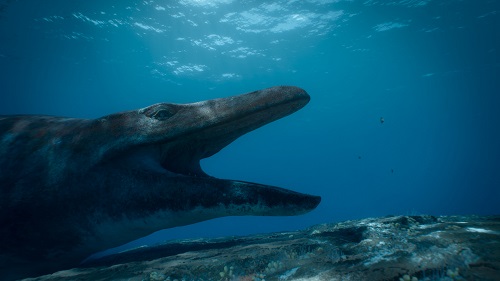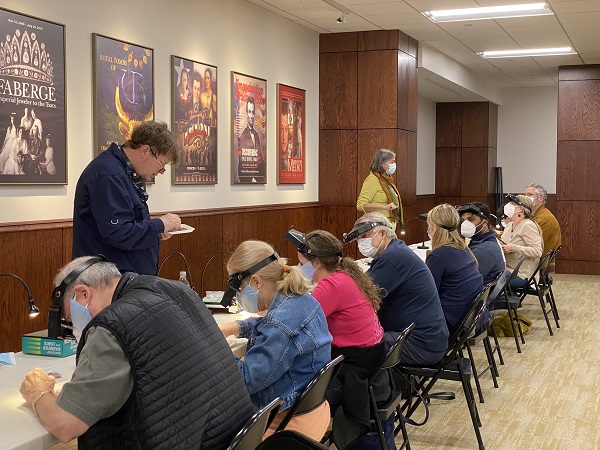We’ve been pondering the problem of Dimetrodon-on-Dimetrodon violence. It’s a Red Beds tragedy; fin-back reptiles were nibbling each other’s brain bones and gouging each others’ cheeks.
But now, maybe, we have some evidence for the softer side of fin-backs: hickeys and love-bites.
Here’s a scientifically precise reconstruction of one fin-back smooching another on the back of the neck, sort of like the cover for a Permian romance novel: Fifty Shades of Red (Beds).
Neck-nibbling is quite the thing among living species of predators, both large and small. Cats do it. Go to Animal Planet and see male lions grabbing the lioness by the nape. Or come visit our Seymour digs in north Texas and meet “Elton,” the male Mountain-Boomer Lizard. Male Mountain Boomers, aka “collared lizards,” are the brightest lizards in all of the Lone Star State. Not “bright” as in “smart,” but as in wearing “fabulous iridescent blues and pinks and yellows in the mating season.” Elton stakes out a wide, flat area in our quarry where he struts his stuff, doing Marine-style push-ups to attract females and frighten away younger males. Every spring he succeeds in enticing a healthy female, almost as muscular and buff as he is.
Here’s a portrait of Elton, snapped by David Temple, Curator and Herpeto-photographer extraordinaire.
(Warning: If you keep Boomers in captivity, never have two males together in a small cage. They’ll beat the coprolites out of each other. The same warning often applies to keeping two curators together.)
Actual Boomer mating includes neck-grabbing. Elton has an extraordinarily wide forehead housing mighty jaw muscles, so the love-nibble has force behind it. If she’s willing, the female displays a hunkered-down posture and shows off her red dots. Therefore, when the female Boomer signals “Bite me!” it’s in fact a “Come hither!” message.
Here’s a fine snap of a female Boomer, from Mike Cong Wild Photography.
Elton does NOT view us humans as a higher species. He’ll race to where we’re digging under the shade of a tarp and give us the hairy eyeball, lizard-style, cocking his head right and left. Then out he goes to ascend his viewing stand, a foot-tall sandstone block 20 feet away. I think he’s checking us out to make sure we are not competition for his favorite lizard-love.
Given such behavior by Elton, we expect that our 400-pound Dimetrodons engaged in some sort of gnathic-cervical love-grabbing. Do we have petrified evidence? You bet. Here’s a cervical vertebra number two, the big bone right behind the head. It belongs to a full grown D. loomisi, a species nicknamed the “Keira Knightly Finback” because of the excessively long, slender neck. The arrow points to a bite — a powerful nibble that actually removed a piece of bone.
But that’s a bit too big of an ouch. There would be thick muscles running from the vertebra to the back of the skull that flex the head up and down, side to side, and twist the head around. This bite would have gone right through the thick part of the muscles, leading to massive trauma, blood loss and death.
Murder by hickey!
Check out this diagram: On the right you’ll see some of the massive and meaty muscles that are located around the head and neck.
It was a sad day when we realized that our love nibble was instead hard evidence of cannibalism. But the head-neck bites also prove something elegant and marvelous about Dimetrodons. We mammals are, supposedly, the Highest Class. We have the most advanced, most efficient anatomical tools for cutting up our food and digesting it quickly. We are far better than the cold-blooded class Reptilia, or so the textbooks say.
Cold-blooded reptiles today do seem sloppy and inefficient. Nile crocodiles and komodo dragon lizards kill zebra, wildebeest and goats — but once their prey is dead, their table manners are primitive. The big reptiles bite their prey anywhere and everywhere, chomping down on bony snouts and chins where there’s not much meat.
Mammal top predators display far greater precision. The tiger examines his prey carefully before removing bite-sized pieces off the meaty zones. The rear teeth slice meat as efficiently as your neighborhood butcher making prosciutto.
You can do this experiment at home: buy some delicious Texas beef jerky and present a big piece to your hungry dog (or your friend’s). The pup will position the jerky between its rear teeth and slice, slice, slice, GULP. The quick slicing action comes from special features of those rear teeth.
Scrutinize these photos of a wolverine. See the big rear teeth? When the wolverine bites meat, the upper rear tooth slides against the lower tooth, and the teeth hone each other like metal shears. That’s why mammal meat-eaters can cut even tough meat and tendons swiftly.
Fossil predator lairs from the Age of Mammals show that these precision-slicers are old adaptations. When we excavate prey carcasses left by saber-toothed predators like Dinictis and Hoplophoneus (both on display in our new Morian Hall of Paleontology), we see bite marks on the skull bones where there was lots of meat — the rear of the skull, the brain case and the tops of neck vertebrae. The extinct mammals ate like the highly efficient carnivores in today’s world. Saber-toothed cats did not waste much time and energy gnawing bony, meat-poor zones of chin and snout. Neither did the extinct dog-like Hyenodon.
Our Dimetrodon was a very, very primitive reptile. In fact, in most ways, D’don was even more primitive than a crocodile or komodo dragon. One big deficiency was the set of meat-slicing teeth. Dimetrodons didn’t have the enlarged self-sharpening chompers. The upper rear teeth could not slide past the lowers in a honing action. Therefore, so the theory goes, a Dimetrodon would have been sloppy and slow and inefficient when dismembering big carcasses.
If D’dons were really as sloppy as crocs and komodo dragons, then we’d find bite marks all over skulls and necks. But if D’dons were careful and efficient, they would have left tooth marks concentrated on the meaty zones of heads and necks.
When we analyzed bite marks on all the necks and heads from our digs, I was flabbergasted. (Talk to anyone in the lab — Dr. Bob hardly ever gets gabberflasted.) Our supposedly primitive Dimetrodon did not bite a la lizard. Or a la crocodile. Or a la gator. Bite marks were targeted with consummate precision. Little energy had been wasted gnawing at non-meaty parts. Bony snouts and chins were not chewed upon. Instead, the tooth marks had been concentrated on all the most meaty zones of the head and cervical region. Bites on the braincase are exactly where big, thick muscles attached. Bites on the cheek are where the jaw muscles attached. Bites on the neck are where the thickest cervical flesh was located.
I have new respect for the Texas Red Beds Dimetrodon. Whenever we unearth another D’don victim, I doff my hat in honor of its masticatory prowess. Our modern mammal efficiency began a hundred million years earlier than we had thought. And now, when we do lunch at Smokey Bros Barbecue and we chew succulent brisket and bring a doggy-bag back to Skippy, we thank our fin-back ancestors.













